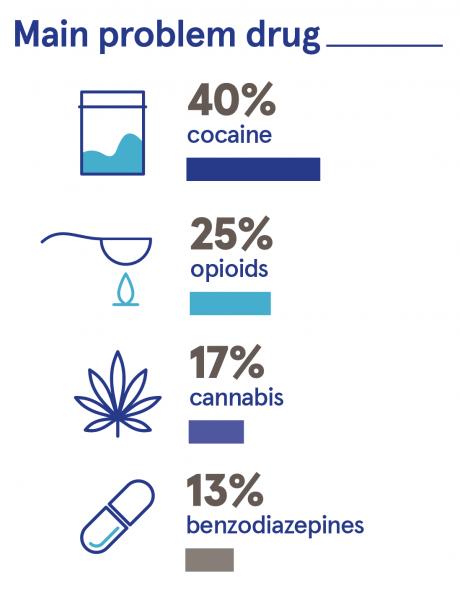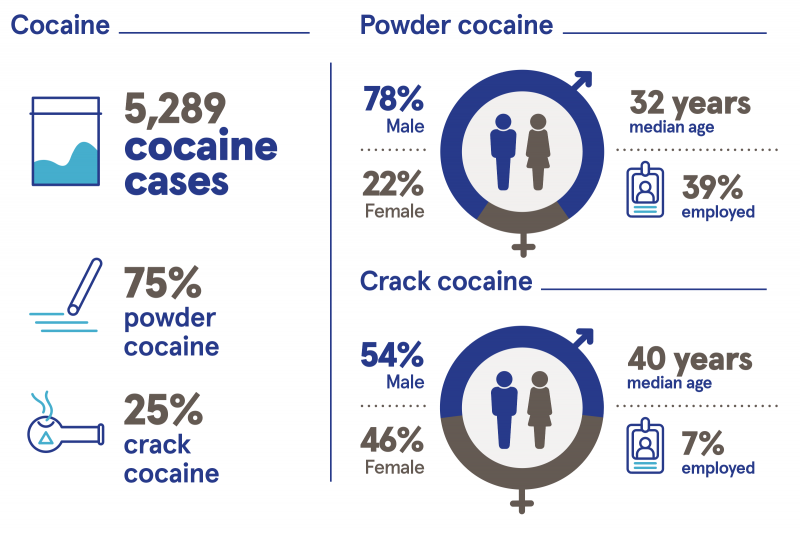Lynch, Tiina  ORCID: https://orcid.org/0009-0003-0864-4417 and Tierney, Paula
ORCID: https://orcid.org/0009-0003-0864-4417 and Tierney, Paula  ORCID: https://orcid.org/0000-0003-0428-9457
(2025)
2024 Drug treatment demand.
Drugnet Ireland,
Issue 92, Autumn 2025,
pp. 34-36.
ORCID: https://orcid.org/0000-0003-0428-9457
(2025)
2024 Drug treatment demand.
Drugnet Ireland,
Issue 92, Autumn 2025,
pp. 34-36.
| Preview | Title | Contact |
|---|---|---|
|
PDF (Drugnet Ireland 92)
3MB |
Published in May 2025, the latest report from the National Drug Treatment Reporting System (NDTRS) presents data on treated problem drug use (excluding alcohol) for the year 2024, and on trends for the eight-year period from 2017 to 2024.1
Key findings 2024
In 2024, 13,295 cases were treated for problem drug use. This is the highest annual number of cases recorded by the NDTRS to date. Cocaine was the most common drug reported among new cases entering drug treatment, accounting for almost one-half of new treatment demand. Cocaine was also the most common problem drug generating treatment demand for those aged 20–44 years. Until 2023, opioids had been the main problem drug for cases aged 35 years and over.
More than one-half (58.0%) of the cases had been treated previously, and opioids were the most common problem drug among this group. The proportion of previously treated cases reporting cocaine as a main problem continued to increase in 2024. Fewer than 4 in 10 (35.9%) of the cases were never treated before. The proportion of new cases reporting cannabis or opioids as their main problem drug has decreased. Most cases were treated in outpatient facilities (70.1%).

Main problem drugs generating treatment demand
Cocaine was the most common main problem drug reported in 2024, accounting for more than one in three (39.8%) cases. Opioids, mainly heroin, were the second most common main problem drug reported in 2024, accounting for one in four cases (25.0%). Cannabis and benzodiazepines were the third and fourth most common main problem drugs reported in 2024, respectively. The number of cases reporting a new psychoactive substance (NPS) as a main problem drug increased from 114 to 170 (49.1%) between 2023 and 2024, with synthetic cannabinoid-type drugs followed by synthetic stimulant-type NPS drugs as the most commonly reported. In 2024, 100 cases reported vaping as a route of administration, of which more than one-half (54 cases) were vaping their main problem drug.


Cocaine treatment demand
Between 2023 and 2024, the treatment demand for powder cocaine increased by 6.4% (237 cases), while the treatment demand for crack cocaine increased by 10.7% (128 cases). In total, 5,289 cases entered treatment for cocaine in 2024.
Sociodemographic characteristics of cases varied by the type of cocaine used. Proportionally, females were more likely to require treatment for crack cocaine (45.6%) than powder cocaine (22.4%). Those in treatment for powder cocaine were more likely to be employed (38.8%) than those in treatment for crack cocaine (7.2%). The median age entering treatment was lower (32 years) for those seeking treatment for powder cocaine than crack cocaine (40 years).
Over the period 2017 to 2024, there was a 252.6% increase in the number of cases where cocaine was the main problem drug. Powder cocaine increased by 216.0% from 2017 to 2024 and crack cocaine increased by 668.2%. Between 2017 and 2024, there was a 426.1% increase among females who have sought drug treatment for cocaine, from 284 cases in 2017 to 1,494 cases in 2024. Cocaine is the most common drug reported among new cases entering drug treatment, accounting for almost one-half (46.8%) of new cases. Numbers of both new and previously treated cases reporting cocaine as their main problem have increased since 2017.
Opioid treatment demand
In 2024, 3,326 cases were recorded with opioids as a main problem, most of which were seeking treatment for heroin (86.8%). Treatment demand for opioids decreased by 17.2% (690 cases) between 2017 and 2024, and the number of new cases almost halved from 807 in 2017 to 413 in 2024. For cases with opioids as the main problem, 31.6% were female, 11.3% were employed, and 16.7% were experiencing homelessness.
The median age entering treatment for opioids rose from 34 years in 2017 to 40 years in 2024. More than one-half (50.9%) of cases entering treatment for opioids were aged 40 years and over in 2024, compared with just over one-quarter of cases in 2017 (26.7%).
Polydrug use was common and reported by 65.3% of cases entering treatment for opioids. The most common additional drugs were cocaine (62.9%), benzodiazepines (47.0%) and cannabis (40.5%). Just under one-half of cases (47.1%) entering treatment for opioids in 2024 had ever injected and 74.9% of those reported currently injecting.
1 Lynch T, Tierney P and Lyons S (2025) National Drug Treatment Reporting System, 2024 Drug Treatment Demand. HRB StatLink Series 23. Dublin: Health Research Board. Available from: https://www.drugsandalcohol.ie/43052
B Substances > Cocaine
B Substances > Opioids (opiates)
B Substances > New (novel) psychoactive substances > Benzodiazepines
G Health and disease > Substance use disorder (addiction) > Drug use disorder
J Health care, prevention, harm reduction and treatment > Treatment and maintenance > Treatment factors
VA Geographic area > Europe > Ireland
Repository Staff Only: item control page